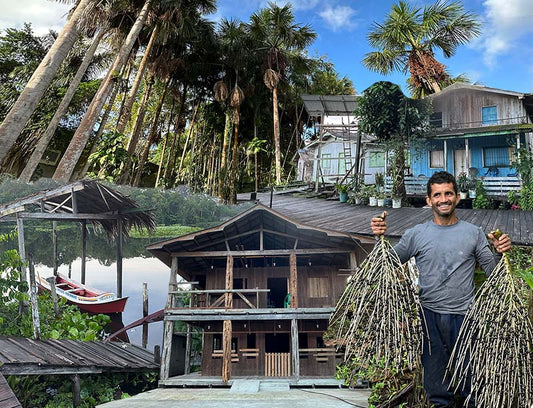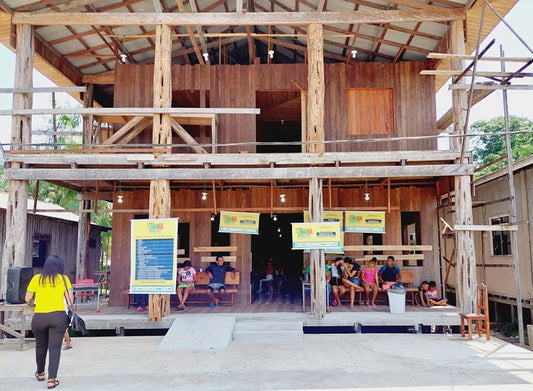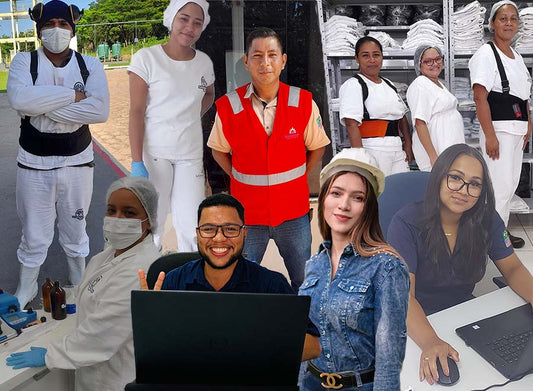21 years ago, I had my first açai bowl on a trip to the northeast of Brazil with friends. The experience was exciting and memorable. A new fruit, a new flavor, a “smoothie in a bowl” eaten with a spoon with multiple textures and tastes, captivated my attention and taste buds. It was delicious, it was functional, it was adventurous. My friends and I, and turns out millions of others, become addicted to the açai flavor, the frozen ice-cream-like texture, and the energy rush it provided from both the sugar and a caffeine kick provided by the guarana, another Amazonian extract with an Amazonian background. It was love at first sight.
In the pursuing weeks, and upon returning to California, my addiction turned to a bit of an obsession. I started thinking about the business opportunity of introducing this superfood to the United States market. Every time I peeled another layer from the onion, it got better. I found out that the açai fruit had a nutritional profile more like olive oil or avocado combined with blueberries or pomegranates. It was full of healthy omega fatty acids and incredible amounts of antioxidants and even fiber: nutrients that are known to provide energy while cleansing the body and fighting free radicals.
I continued researching and read how açai had just been “discovered by the media”. With this recent fame, the demand in the Brazilian Amazon for this superfood was skyrocketing. I learned how açai grew on tall palm trees in the Amazon’s Varzea, or floodplains, and that up until the early 90’s outside of the North, the average Brazilian had never even heard of açai. The berries come from the same tree as the heart of palm, which was certainly more common and what the trees were generally cultivated for up until that time.
The people who worked with the açai palm trees lived out in rural Amazonia, mostly on small plots of land tended by the local families who lived on them. Besides the parents and children, these families also include the grandparents, and so the average family size is typically five to ten people.
To survive economically, most families engaged in a number of local activities to earn money such as fishing, shrimp farming, fruit and herb cultivation, or extraction of the heart of palms from the açai palm tree. Despite these activities, most of these local people lived in extreme poverty, earning less than Brazil’s typical minimum wage of about $150 per month, which is nearly impossible to survive on, no matter what country you live in.
This struggle to earn a living in rural Amazonia often leads to a “rural exodus” where families must abandon the forest and move to the cities to find work. Rural exodus has been linked to loss of culture and contributes to overcrowding and poverty in the urban cities which over the last 30 years has also become a major problem for the Amazon region contributing to malnutrition, homelessness, pollution, and exploitation of women and children.
Alternatively, you have the heads of the household and sometimes also older youths who leave their communities to find work upriver or in more industrialized areas and can be gone for months on end. This can lead to emotional stress for the mothers and children, and long stretches between the person working bring money back to the family to pay for basic needs. The men generally go to work among other industries; mining, soy, cattle ranching, timber, charcoal, etc., which are dirty, dangerous, detrimental to the health of the workers, and huge contributors to environmental destruction, deforestation, and climate change.
Then there was açai; the new and highly demanded, highly lucrative, and abundant palm tree growing in their front (and back) yards. This was better than the heart of palm trade environmentally because it didn’t require cutting down and killing the tree. It was part of a wild-harvested system so biodiversity was not only protected but increased compared with the outright removal of the trees common in basically every other available system in the Amazon. It wasn’t grown on a plantation so it didn’t require the harmful herbicides or pesticides or irrigation or fertilizers which are prevalent in monocultures like soy, coffee, coconuts, or bananas. It provided a living wage to the small family growers, keeping people on the land rather than in the cities or working in some far away toxic or destructive industry, and helped protect the biodiversity of the Amazon Rainforest. No wonder they call it a superfood with delicious powers!
Locals call açai the “gold of the Amazon” because it is so abundant and when sold, proved that money actually did, and does, in fact, grow on trees. We found a story on the Greenpeace website that said, “…the deep, purple, tiny açai berries are the most important non-timber forest product (NTFP) in terms of money for the people of the Amazon Rainforest”.
I remember sitting with my co-founders one afternoon and saying wow, can you believe that this gift of a superfood is unknown in most of the world and that its’ industry is in its’ infancy? …And that if we are successful that we may just look back in 20 years and have helped shape an industry? We imagined if açai not only had a protected domicile like Champagne in France or Tequila in the five areas of Mexico, it could be recognized internationally not only by the region from where it came but what if we could make it a “sustainable” commodity? This would require organic and fair trade certification and thousands of certified growers. It could happen. We set out to share this story and sample this fruit to anyone and everyone we could, and each time we did, the result was a “Purple Smile”, no matter the age, city, or country.
As we dove into the supply chain, we learned pretty quickly that the product was changing hands many times through a series of middlemen which could result in exploitation of the growers, often leaving them with a very small portion of the income the açai ultimately sold for. We went deeper, studying the entire supply chain and uncovering inefficiencies that either left the people upstream at the base of the supply chain with less than their fair share, or opportunities downstream to improve the processing standards.
As the scaled açai market was less than a decade old, we realized that modern industrial standards did not yet exist, nor did any social or environmental standards, regulations, even best practices. So, we decided to pioneer them, enlisting experts from local and international NGOs, certification bodies, and academics.

I remember being told that it didn’t really matter how “sustainable” or “green” our project might be if there was no “pull” or consumer demand for the product. We knew that to have any potential for real impact in the region we needed to create demand and awareness for this forest product in the USA market. We started with formalizing industrial standards to have a pasteurized açai product that could be exported around the world and meet the highest levels of food safety. We also started essentially going door to door to juice bars in California with a small team with the amazing story of certified açai and product samples to share.
We began studying a philosophy called the Triple Bottom Line, which measures success socially, environmentally, and economically. We were beginning our economic activity by buying and selling the product, but in terms of any environmental success to measure there was no certified organic açai, and as it is a wild harvest crop no certifiers from any standard had ever considered how to apply those standards to this product. We sponsored one of Brazil’s biggest NGOs, FASE, and the world’s açai expert, Herve Rogez, a Belgian researcher living in the Amazon, to develop organic systems plan for açai.
Then we took the leap and contracted with an American organic certifier to travel down to the field and evaluate our operations and ensure our hard work met the rigorous standers required for organic certification. SAMBAZON became the world’s first organic certified açai and later influenced many other açai companies to follow in our footsteps.

This type of work is called “Sustainable Agroforestry”, and with our team of experts, public and private institutions, and a whole lot of passion and inspiration we completed a series of trainings with four different cooperatives in the Para region which in total represented some 400 families or 4,000 people. Below is a picture of one of the first meetings with one of the Cooperatives.

Our harvester program entailed producer guidelines, technical assistance monies, and training which encouraged best practices to achieve higher yields and quality, while prohibiting other practices including the use of chemicals and pesticides. We focused on the proper spacing of the trees to not promote intensification or monoculture and the protection of the forest’s biodiversity. Much time was spent explaining documentation and chain of custody requirements so that we could meet the proper compliance, auditing, and transparency required by the organic systems plan recognized by the US Department of Agriculture NOP and other organic bodies around the world.
Even as a startup, selling less than $10k of açai per month in the USA, we initiated these programs and also paid a premium on the market price of the açai to the newly certified growers for this extra work and documentation required. We made these investments despite hardly making enough to support ourselves or our marketing efforts to create awareness and demand let alone the multiple NGOs and third-party agencies, we were committed to. We believed in the Triple Bottom Line and knew it would pay dividends in the future.
On the social measurement side, it was even more complex. There did not yet exist any certifying body which offered a Fair Trade certification for açai. To offer such a certification, there would need to be a team on the ground to determine best practices, monitor and adhere to the yet-to-be-developed rules and enforce compliance. Unlike the organic certification which had well-developed regulations, the local NGOs or the cooperatives were unable to provide such a service. Giving up was not an option and fair trade was beginning to be talked about for other cropping systems and we found a US-based organization called the Fair Trade Federation which we could become members of and design our best practices according to their rules. This was 2003, before a certification for açai existed. Then in 2008, EcoCert, who by that time we were working with as our official organic certifier, began to offer Fair Trade certification for the açai palm tree based on many of the Fair Trade Federation programs we had developed.
SAMBAZON and EcoCert developed and implemented a Fair for Life system with international guidelines including a program whereby with each dollar of açai we purchase from the grower communities, we would pay additional monies into a “Fair Trade Fund” which we would distribute annually across our grower communities. This fund has been used to build or renovate schools, employ teachers, fund health care facilities, after-school programs, etc. To date, SAMBAZON has reinvested ~$1,000,000 directly into these communities from this Fair Trade Fund.
Fair Trade as a social certification is important because it not only guarantees a fair wage but also ensures transparency and third-party auditing and compliance in the supply chain. The Eco-Cert Fair Trade certification states that growers must be paid a fair wage no matter how low the cost of the product would be. Developing a transparent chain of custody, fair trade certification highlights the commitment of certified operators like SAMBAZON for continuous improvement, with a long-term approach, at each stage of the value chain. SAMBAZON has set a bar with growers in the Amazon region and gained a reputation for strict guidelines for these certifications.
Not only is Fair Trade one of the best social measurements to ensure fair wages, but it is also a key compliance certification for labor practices including child labor. The International Labor Organization (ILO), defines child labor as work that deprives children (any person under 18) of their childhood, their potential and their dignity, and that is harmful to their physical and/or mental development. SAMBAZON strictly opposes child labor and is committed to eradicating it through education and third-party certification and compliance.
We celebrate Fair Trade this month and the standards we helped establish which are now becoming norms in the açai industry. We are delighted that many of our fellow companies working with açai have adopted these principles, including organic certification and fair trade certification, resulting in raising the standard of living for the growers and their families. This increase in income through sustainable agroforestry encourages more time to be devoted to education and family, and less time required to leave their homes and communities to seek income elsewhere.
Over the last two decades, the fruits of our labor have paid off with Triple Bottom line success. Though it has taken us some time and a lot of hard work, SAMBAZON is now thriving economically, environmentally and socially more and more each year.
20 years in the making, we are SAMBAZON - Sustainable Development in the Brazilian Amazon.







Comments
(0 Comments)Please note, comments need to be approved before they are published.